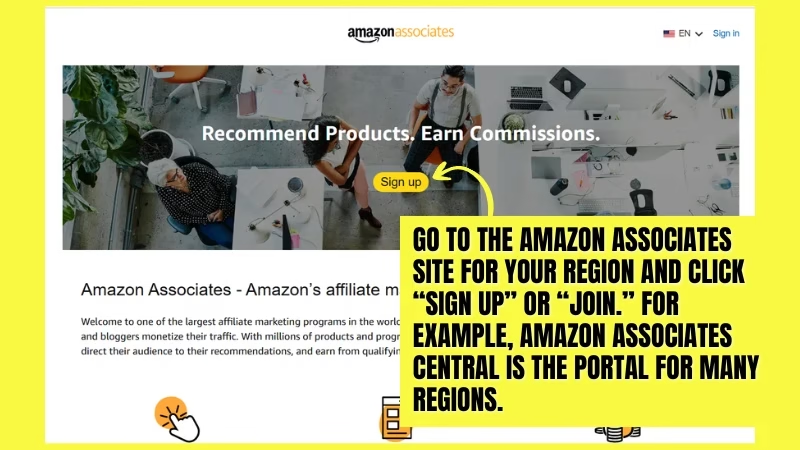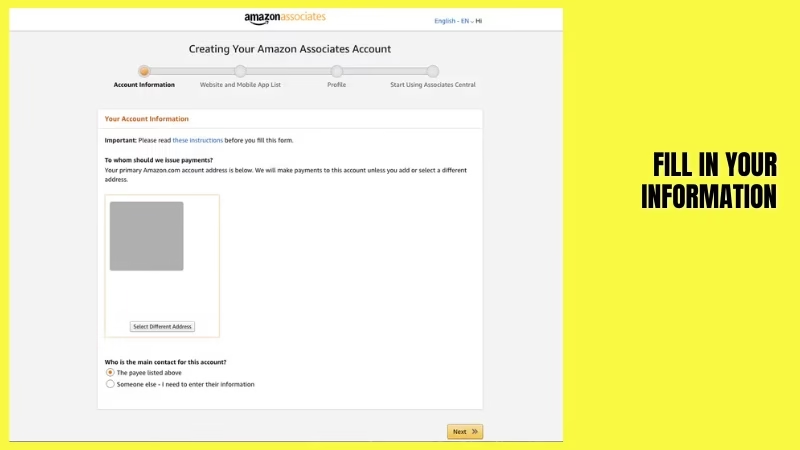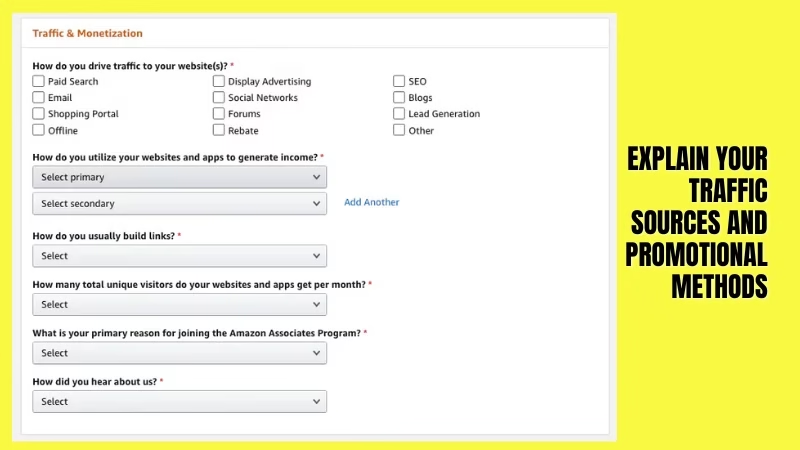Table of Contents
In today’s digital era, making an additional income is considered a luxury for the majority. One of the easiest and proven channels to earn extra income is affiliate marketing. The Amazon affiliate program, often called Amazon Associates, still remains one of the most stable, flexible, and highly trusted amongst any other programs offered. In this article, we are going to look at how the Amazon affiliate can be your side hustle in 2026 by going through all the basic steps, hidden tips, pitfalls you should avoid, and advanced strategies you ought to know.
1. What Makes Amazon Affiliate a Great Side Hustle?
Before diving into how, let’s understand why the Amazon affiliate program remains a go-to choice for people who want a side income:
- Simplicity and accessibility: There exists no creation of one’s products, no stocking, and no direct relation to customer service. Simply put, you promote products available under the Amazon umbrella, and you gain a commission for sales made through your link.
- Vast catalogue of products: Having millions of products in different categories, there is surely something to promote depending on your interest and niche.
- Trust and conversion: The majority of people trust buying on Amazon. Keeping it familiar increases conversion rates, as your audience would not even have to take the risk of exploring a new site or brand.
- Scalable: From small beginnings, big and more will follow as you grow and learn.
- Recurring potential income via bounties and special programs: Amazon rewards actions besides sales, such as grabbing a Prime signup, which can increase your income.
Because of the presence of low-risk entrance, huge reach, and possible earning mounts, Amazon affiliate works great as a side-hustle, which you do in your free time and grow at your own pace.
Also Read: Best Side Hustles with zero upfront cost!
2. Understanding the Amazon Affiliate Market in 2026
Without the terrain changes being understood, 2026 will not be a possibility:
- Affiliate marketing going up: Globally, the affiliate marketing market is expected to grow at around 10% per annum massing up in new verticals.
- Voice Search & Conversational Commerce: Increasingly, these product searches will be conducted via voice-enabled mediums such as smart speakers and inbuilt voice assistants by 2026. It changes how we discover products.
- Changing content type: Short videos, live sellers, social commerce, and micro-influencers are all rising. Regular blog posts will still count for something but must be adapted in their style and format.
- Attribution and fines: Amazon has now tightened its attribution rules so as to prevent banned practices (for instance, to prevent earning on the same traffic in different programs).
- New opportunities: Amazon’s native commerce ads are being tested (paid for traffic, not sales), which may open new revenue streams for publishers.
By the year 2026, the Amazon affiliate market will be thriving more and more but being less and less able to compete and demand strategy, compliance, and content quality.
Also Read: 7 Best Side Hustles you should try at least once!
3. How to Become an Amazon Affiliate — Step by Step
Here’s a practical, step-by-step guide on how to become an Amazon affiliate:
Step 1: Decide which Amazon storefront to use.
Amazon does have many country-wise affiliate (Associates) programs — for instance, amazon.com (USA), amazon.in (India), amazon.co.uk, etc. Select your program(s) based on where most of your audience forms a local bulk. You may also join all of them if your audience extends across regions.
Step 2: Go to Amazon Associates / affiliate sign-up page

Go to the Amazon Associates site for your region and click “Sign up” or “Join.” For example, Amazon Associates Central is the portal for many regions.
Step 3: Fill in your information

You will be required to provide information and complete your profile with details including your name, postal address, website(s) or social media channels, how you intend to drive traffic, and tax/payment information.
Step 4: Explain your traffic sources and promotional methods

Amazon asks how you plan to promote products (blog posts, email, social media, YouTube, etc.). Be honest and thorough — this helps in approval.
Step 5: Receive approval (or provisional status)
Some programs approve you immediately, others might review your site. Amazon generally requires that you make a few qualified sales within a set time (for example, 180 days) to fully confirm your account.
Step 6: Sign in to Amazon affiliate dashboard
Once approved, sign in to your affiliate/Associates dashboard. This is where you generate affiliate links, view reports, see earnings, and manage settings (“Sign in amazon affiliate”).
Step 7: Create affiliate links and banners
Within the dashboard you can use tools to generate tracking links or banners for any Amazon product. Place those in your content.
Step 8: Start promoting and earning
As visitors click your affiliate links and make purchases (or perform bounty actions), you’ll earn commissions — this is the core of how to become an Amazon affiliate in practice.
That’s the basic flow. The real success lies in execution, optimization, and compliance.
Also Read: 20 Easy Side Hustle Ideas!
4. Choosing a Niche — The Foundation of Success
A common beginner mistake is to promote everything. That approach rarely works, because you can’t attract or retain an audience that way. Instead:
- Pick a niche (for example: tech gadgets, home decor, fitness gear, pet supplies, travel accessories)
- Make sure the niche is big enough to have multiple products and demand
- Check competition and margins (some niches have higher commission rates)
- Align with your interests or expertise (makes content easier)
In each niche, you’ll choose product categories, thematic topics, and ways to bring value to your audience.
5. Types of Content and Channels That Work
To make the Amazon affiliate program your side hustle, you need a channel to reach people. Here are effective types:
Blogs / Websites
Long-form articles, reviews, how-to guides, comparison posts, and listicles (“Top 10 best …”) are time-tested and still valuable for SEO and evergreen traffic.
YouTube / Video Content
Product reviews, unboxings, tutorials, roundups. Embed or mention your affiliate link in video description or as overlay.
Short-form Video / Reels / TikTok / Shorts
Short, snappy product showcases or micro-reviews with a call-to-action—these are growing fast.
Social Media & Carousels
Instagram posts or carousels, Pinterest pins, Facebook posts. Pinterest in particular works well with links and visuals.
Email Newsletters
If you build an email list, you can send curated product recommendations to subscribers — very high conversion potential.
Niche Micro-sites
You can create small, focused mini-sites (microsites) around narrow topics (e.g. “best travel adapters”) and monetize them with affiliate links.
The key is: pick a primary channel (or two), start building content, and grow steadily.
Also Read: Innovative and easy side hustle that anyone can start!
6. Building Traffic — Free and Paid Methods
To make your side hustle really work, you need traffic (people to see your links). Here are common approaches:
Organic / Free Traffic
- SEO (Search Engine Optimization) — optimize for keywords your audience uses, write content that answers questions, build internal & external links.
- Social media reach — grow followers, share content, engage.
- YouTube / video SEO — apply video titles, descriptions, thumbnails that attract clicks.
- Pinterest — pins last long, can drive lasting traffic.
- Collaborations / guest posts — cross promotions in your niche community.
Paid / Accelerated Traffic
- Paid ads (Google Ads, Facebook Ads, YouTube Ads) — can bring immediate visitors, though must be used carefully with affiliate policy compliance.
- Sponsored content / influencer promotion — you promote content via another influencer’s audience.
- Boost posts on social media — small budgets to get initial traction.
A balanced approach is often best: start free (organic) traffic, then reinvest some profits into paid traffic for scaling.
7. Conversion, Tracking & Attribution Changes
Here’s where many affiliates lose money or get surprised. Understanding how Amazon tracks your referral actions is vital.
Cookie Duration & Attribution
When someone clicks your affiliate link, Amazon places a tracking cookie. If they buy within the cookie window (often 24 hours), you get commission not only on that product but also on other unrelated items they purchase during that session. However, the cookie period is short, so conversion must happen quickly.
Attribution Changes
As of late 2024, Amazon updated its policy to prohibit earning duplicate or triple commissions on the same traffic via other networks. You can’t layer multiple affiliate tags for the same purchase traffic. This shift demands you manage link attribution carefully.
Additionally, Amazon may discount (or disallow) commissions if purchases are returned, canceled, or if fraudulent.
Tracking tools like “OneLink” or link localization help affiliates serving global audiences (so that a user in India clicks an amazon.in link, etc.).
Performance Reports & Analytics
Your Amazon affiliate dashboard gives data like clicks, conversion rate, earnings per click, best-performing products. Use these to refine your content and promotion strategy.
8. Income Models, Commission Rates & Bounties
Not all earnings come purely from product purchases. Amazon has a few ways you can earn.
Standard Commissions
These vary by category. For example:
- Luxury beauty: ~10%
- Digital music, digital videos, handmade: ~5%
- Books, kitchen, automotive: ~4.5%
- Fashion, devices, accessories: ~4%
- Home, furniture, outdoor: ~3%
- PC & components: ~2.5%
- Health, groceries, video game consoles: ~1% or lower
- Some items like gift cards, services, etc. might yield 0%.
These numbers are typical as of 2025 and may adjust over time.
Bounty (Special Actions)
Amazon also rewards certain actions or program enrollments, sometimes called bounties. Examples:
- Prime Free Trial signup
- Paid Prime membership
- Certain subscriptions or program enrollments
These bounty payments are fixed in dollar value, not percentage-based, and can significantly boost income beyond product sales.
Other Models
- Native commerce advertising: Amazon is piloting a system where you can earn just by directing traffic (even if purchases happen later).
- Flat-rate deals: Some affiliate deals might offer fixed payments for actions rather than percentage sharing.
By combining product commissions + bounties + other opportunities, you diversify income streams.
9. Compliance, Rules, and Avoiding Pitfalls
Affiliate programs are built on trust. Amazon is strict about rules, and breaking them can get your account terminated. Here’s what you must watch:
- Always display a disclaimer: e.g. “As an Amazon Associate I earn from qualifying purchases.”
- Don’t cloak or hide affiliate links (unless using Amazon-approved link shorteners or redirection compliant with their policy).
- Don’t embed affiliate links in user-generated content or comments (some policies ban posting links in forums, replies).
- Avoid encouraging people to click your link artificially (e.g. “click here even if you don’t want the product”).
- Stay updated with Amazon’s Operating Agreement — policies can change.
- Ensure that your content is genuine, accurate, not misleading. Amazon can penalize affiliates for false claims.
- Watch for returns, fraudulent purchases, or invalid traffic (some clicks may not be valid).
- Don’t reuse links across multiple accounts or attempt to game the system with multiple tags.
- Keep your traffic sources transparent and avoid black-hat SEO or scraping methods.
Treat compliance as foundational. It’s not optional.
10. Scaling Up — From Side Hustle to Full-Time Income
Once your side hustle is finally able to generate consistently high income, the scaling may take the following courses:
- Start more niche sites, or set up more content verticals for other products.
- Hiring content writers, video editors, and SEO specialists.
- Reinvesting profits in paid traffic and promotion.
- Funnel activities such as lead magnets, email sequences, and retargeting.
- Income diversification: other affiliate programs, complementary digital products, or higher-paying offers.
- Always optimize to go international (localized links, and joining several Amazon affiliate programs).
- Go branding — create own products, own line, and e-commerce later.
Scaling narrows down to turning a one-man show into a small outfit with systems, delegation, and reinvestment.
11. Advanced & Lesser-Known Tips for 2026
Here are some insights and tactics not everyone knows, but which can give you an edge:
- Leverage AI & automation: Use AI tools to help with content ideation, outline, keyword research, drafting, or rewriting. But always human-edit and ensure factual accuracy.
- Semantic / topic-cluster SEO: Create hub pages with subtopics, internal linking, and topical authority.
- Use “module” content: Instead of full posts, publish smaller update modules (e.g. “Best headphones 2026 update”) to refresh content more frequently.
- Voice & conversational content: Structure pages as Q&A or “how to / question-answer” so voice assistants surface your content.
- Dynamic pricing & deals: Use Amazon’s API or tools that detect price drops or deals, and update your content or alerts to your audience.
- Bundle & upsell content: For example, one article reviews a camera + accessories kit; your audience may buy multiple items in one session.
- Seasonal & trend content: Watch product trends, seasonal gift guides, holiday promotions—capable of surges.
- Dive into micro-niches: Instead of aiming for “fitness equipment,” go for “adjustable kettlebells for small apartments” — lesser competition and more targeted audience, I would say.
- Retargeting & email sequences: If you manage to gather email addresses somehow (via content or freebies), then you can go on to send reminders, new product suggestions, or seasonal favorites.
- Native commerce / “traffic-based” revenue: Keep an eye on Amazon’s evolving programs like NCA, which might let you earn simply for directing traffic (not just for purchases).
- Cross-platform syndication: Republish in different formats (audio, video, newsletter snippets), capturing different audience segments.
The affiliates who adapt and experiment will likely outperform those who stick to old methods only.
12. Realistic Expectations, Challenges & Mindset
It’s important to be realistic. Many people try affiliate marketing expecting instant riches, but:
- It takes time (months) to build meaningful traffic and conversions.
- Earnings are often small at first (a few dollars, then tens, then hundreds).
- You’ll face content fatigue, algorithm changes, or occasional dips in traffic.
- You may see commissions decrease if Amazon cuts rates.
- Competition is intense in many niches.
But with perseverance, consistency, learning from data, and adaptation, many affiliates grow to full-time income levels.
Mindset tips:
- Focus on value first: help your audience, solve problems, earn trust.
- Treat it as a long-term game, not a get-rich-quick scheme.
- Be patient and adaptable.
- Measure everything, and double down on what works.
- Reinvest profits (into tools, education, content) to accelerate growth.
Final Thoughts
In 2026, the Amazon affiliate program remains a powerful and viable side hustle. With the right mindset, consistent effort, and smart strategies, you can turn it from a small extra income into something substantial. The key steps are:
- Learn how to become an Amazon affiliate and get your account set up.
- Choose a niche and create valuable content.
- Build traffic (organic + paid).
- Understand commission structures, bounties, and attribution.
- Stay fully compliant and avoid pitfalls.
- Experiment with advanced tactics and scale over time.
If you treat it as a serious project rather than a hobby, and remain patient, your “side hustle” can grow into a primary revenue stream.

